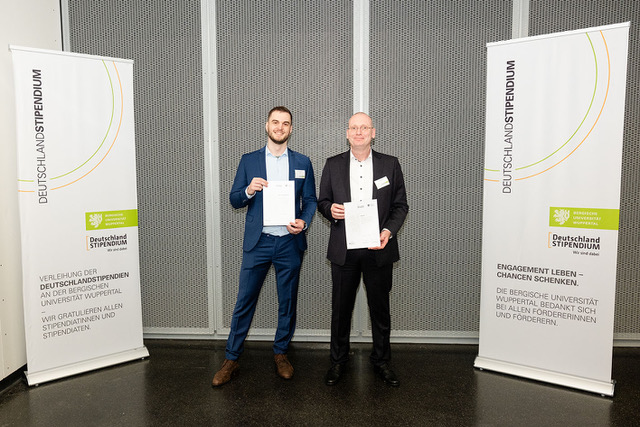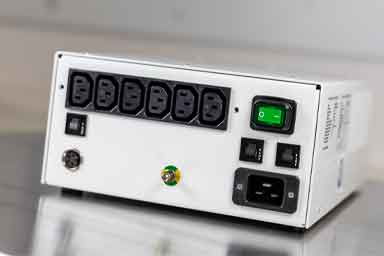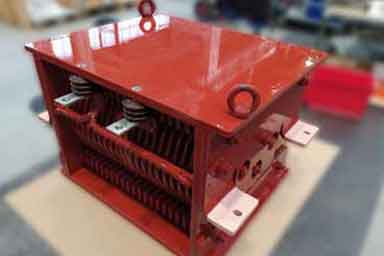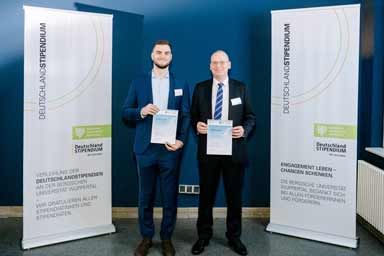DC LINK CHOKE N CNW 891

Single-phase DC link choke (1 conductor) Description Compact & Efficient Reduce mains interference – save energy costs. The DC link choke is used to smooth the DC link current and reduce mains feedback in voltage DC link converters. The typical combinations of rectifiers and capacitors place a considerable load on the supply network. Due to its function, the current consumption of the power supplies or converters is not sinusoidal, but pulse-shaped at the moment of the voltage maximum. DC link chokes reduce the harmonics and relieve the supply network in a similar way to the mains choke. In addition, the DC link choke dampens the charging current peaks of the DC link capacitors. A DC link choke reduces the burden on the supply network with harmonic reactive power. Improvement of the efficiency of a converter (Power Factor Correction). Inrush currents and current peaks are damped by up to 70%. Mains chokes help to comply with the international PowerQuality standards IEEE 519 or EN 61000-3-2. Typical application Drive technology for motor drives, e.g. mechanical engineering, elevators, escalators, pumps, conveyor technology, ventilation and air conditioning, robotics, automation technology, power supplies, wind turbines Benefits Reduction of harmonic overtones Damping of current peaks up to 70% compact design Advantages compared to the mains choke: smaller size lower material costs / price lower power dissipation Production according to UL insulation system E251513 possible Technical data Nominal voltage: U ≤ 600 V According to: EN 60289 / EN 61558 Test voltage: L-PE 4000 V, AC/50Hz, 60s Insulation class: T40/F Protection class: IP00 Climate category: DIN IEC 60068-1 Overload: 1.5 x INominal 1 min / h Design: standing on foot bracket Technical data Type Nominal voltage U [V] Nominal current [A] Inductance [mH] Power dissipation [W] Mass [kg] Mass Cu [kg] N CNW 891 / 8 600 50 / 60 Hz 8 9,4 14 1,4 0,3 N CNW 891 /11 600 50 / 60 Hz 11 6,2 15 2 0,3 N CNW 891 / 15 600 50 / 60 Hz 15 4,8 20 2,8 0,6 N CNW 891 / 20 800 50 / 60 Hz 20 3,3 19 3,6 0,6 N CNW 891 /28 800 50 / 60 Hz 28 2,4 22 3,6 0,8 N CNW 891 / 34 800 50 / 60 Hz 34 2,0 29 4,5 0,8 N CNW 891 / 40 800 50 / 60 Hz 40 1,6 31 7 1 N CNW 891 / 55 800 50 / 60 Hz 55 1,2 43 8 1,2 N CNW 891 / 70 800 50 / 60 Hz 70 0,98 49 10,5 1,4 N CNW 891 / 85 800 50 / 60 Hz 85 0,81 60 13,6 1,8 N CNW 891 / 100 800 50 / 60 Hz 100 0,67 70 14 2,5 Dimensions in mm Type Length L1 (mm) Width B1 (mm) Width B2 (mm) Height max. H (mm) Mounting N1 (mm) Mounting N2 (mm) Mounting D1 (mm x mm) Connection terminal/ cable lug [mm²] PE connection Connection A1 (mm) Image N CNW 891 / 8 84 76 62 80 64 48 5 x 8 2,5 Flat connector 6.3 x 0.8 1 N CNW 891 /11 84 90 76 80 64 62 5 x 8 2,5 Flat connector 6.3 x 0.8 1 N CNW 891 / 15 96 95 88 85 84 72 6 x 11 2,5 Flat connector 6.3 x 0.8 1 N CNW 891 / 20 96 138 102 85 84 85 6 x 11 10 (m5) M5 40 2 N CNW 891 /28 96 138 102 85 84 85 6 x 11 16 (M5) M5 40 2 N CNW 891 / 34 105 138 105 95 84 87 6 x 11 16 (M5) M5 40 2 N CNW 891 / 40 120 155 120 105 90 105 6 x 11 16 (M5) M6 45 2 N CNW 891 / 55 150 138,5 107,5 135 122 87,5 7 x 13 16 (M5) M6 45 2 N CNW 891 / 70 150 159 124,5 135 122 104,5 7 x 13 25 (M8) M6 45 2 N CNW 891 / 85 150 185,5 150,5 135 122 130,5 7 x 13 25 (M8) M6 45 2 N CNW 891 / 100 174 162,5 121 150 135 101 7 x 13 35 (M8) M8 50 2 Data sheet All data and configurations can be found in our product data sheet. Download data sheet Certifications
REO AG Continues Tradition as a Sponsor within the Framework of the Deutschlandstipendium (Germany Scholarship)

For 7 years now, REO AG has been supporting qualified and talented students with a Deutschlandstipendium.
Isolating transformers for medical technology – ed 3.2

REO AG has successfully completed certification for the new 3.2 edition of its REOMED isolating transformers. This certification will be mandatory from October 2024 and underlines the quality and reliability of the REOMED series, which was specially developed for medical technology. The REOMED series of isolating transformers offer the highest levels of safety and reliability, which are essential for use in medical devices. These transformers are used in a wide range of medical applications worldwide, from hospital equipment to complex medical imaging systems. The REOMED transformers are characterised by their excellent insulation capability and low electromagnetic interference, which ensures safe and reliable operation. One example of the products in this series is the REOMED 2200, which is unique with its nominal output power of 2200 VA and represents a unique selling point. The REOMED 2200 stands out due to its compact design and high efficiency. Thanks to REO AG’s many years of experience and technical expertise, this isolating transformer offers improved voltage stability and optimised heat dissipation, resulting in an extended service life and increased operational reliability. With the successful testing of the 3.2 edition, REOMED isolating transformers are ideally prepared for the future requirements of the market. This certification shows that REO AG continues to offer reliable and safe solutions for the medical technology sector.
Hallo Welt!
Willkommen bei WordPress. Dies ist Ihr erster Beitrag. Bearbeiten oder löschen Sie ihn und beginnen Sie dann mit dem Schreiben!
Mechanical Engineering Network Bergisch Land

The Mechanical Engineering Network Bergisch Land is an association of companies, individuals, and public authorities. Its purpose is to strengthen the mechanical engineering industry in the economic region of the Bergisch City Triangle to secure competitiveness, locations, and employment. The currently more than thirty-five members – small and large companies, institutions, and educational service providers – can exchange ideas and information in various ways on this platform. In addition to the network-promoted interaction between companies and the transfer of knowledge between industry and research, the skilled labor situation is also among the central topics. REO AG is now pleased to be part of this network. As part of the first network meeting with REO AG, board member Mr. Jörg Rohden participated in the excursion to the Machine Tool Laboratory WZL Smart Automation Lab at RWTH Aachen University. The Smart Automation Lab focuses on the continuous improvement of production processes to increase productivity, enhance flexibility, and reduce resource consumption. The Automation and Control Technology department showcased applications and projects on topics such as smart robotics, artificial intelligence in production processes, and collaborative assembly of small parts, using numerous demonstrators. A very exciting look at the state of the art and an outlook on what we can expect in the future.
REO DC Chokes in New Berlin Subway Trains

The unveiling of Stadler’s new JK series subway train marks a significant step in the development of the Berlin rail network. Compared to the trains that are over three decades old, the new train represents a leap into a new technological age. While there are hardly any noteworthy differences on the outside, the JK series impresses with a wealth of innovations on the inside. An improved sense of space, more generous space for standing passengers, and vertical grab bars that make gripping ceiling bars unnecessary are just some of the highlights. The angled grab bars also make it easier for wheelchair users to pass through the aisles. In addition, space-saving screens and an integrated size indication on the signs indicating spaces for the severely disabled are part of the modernized interior. The first test cars have been rolling through the Berlin subway network since January, before being used for the first time in regular passenger service from late summer 2024. The introduction of this new subway train series represents a significant advance in railway technology and lays the foundation for further innovations in the future. The technological advancement is driven by the cooperation between REO TPM and the customer ABB. Together, a special DC grid choke was developed at the end of 2021 to integrate it into the new subway cars. As an essential component of the drive train, this choke provides important protection against circuit-related current peaks and reduces harmful network feedback. A special feature of the DC grid choke is its EMC conformity, which is ensured by the choke being surrounded by thick iron sheets. This ensures that electromagnetic interference is reduced to a minimum, which in turn increases the safety and reliability of the subway operation.
High Current Transformers for Resistance Welding

High Current Transformers for Resistance Welding UK-born engineer Elihu Thomson discovered in 1876 that copper could be fused together, but it wasn’t until 1885 that a resistance welding process was proposed. Direct energy spot welding is a resistance welding process that joins metals by applying pressure while simultaneously supplying electrical current to the weld area. Resistance spot welding has evolved into a fast and cost-effective welding method widely used in sheet metal fabrication. The automotive sector has benefited from this technique through the use of spot welding robots, enabling higher production and assembly speeds. Although this technique is primarily used for welding steel, there is an increasing trend to substitute steel with aluminum to achieve mass optimization over time. The market is estimated to reach nearly $500 million by 2031. Power Supply in Welding Spot welding machines typically operate with AC voltage. The specific power for a given welding application is determined by process development and optimization based on material properties, desired weld quality, material thickness, and speed requirements. The heart of the welding machine’s power supply is a high-current transformer, designed for the maximum power and load that can be expected for the application. REO’s RFT-HS toroidal transformers use multiple toroidal cores to achieve the required power. The units have a standard wired input and use a copper busbar as the secondary side. The toroidal design can be up to 40% more efficient than conventional EI transformers, which is crucial in price-sensitive applications. REO’s toroidal transformers offer further advantages: they can be encapsulated to achieve an ingress protection (IP) rating of up to IP20, and the REO design allows for quick assembly in devices or control cabinets, saving time and thus money. They have been specifically developed to outperform standard EI transformers and offer lower losses. Applications of Spot Welding Automotive Industry As mentioned, spot welding is a key component of the automotive industry due to its cost-effectiveness, reliability, and speed. Manufacturing companies can easily automate assembly lines by using spot welding robots. A sheet metal or pressed panel made of steel or aluminum can be transformed into a functional part in seconds. Electronics Since this welding process prevents overheating of electronic components, many components such as switches, potentiometers, relays, circuit boards, and batteries are well-suited for spot welding. Nail Manufacturing This is a continuous high-speed spot welding process that converts carbon steel coils into thousands of nails per minute. Kitchen Appliances Spot welding is commonly used to manufacture door and cabinet handles, spatulas, and certain kitchen utensils like cookie cutters. Medical Industry The medical industry also benefits from the welding quality and speed of this process. In orthodontics, for example, spot welding is used for the secure attachment of dental implants. Advantages of Spot Welding Spot welding is considered one of the fastest and cleanest welding methods. The process is easy to understand. Unlike other methods such as arc or TIG welding, there is no open flame. The process is easily automated. Multiple workpieces can be joined simultaneously. No use of filler materials required. There is no need for the use of shielding gases. Disadvantages of Spot Welding Workpiece alignment and pressure are critical. Spot welding can cause deformation in some areas of the base metal. It is generally not possible to weld material thicknesses greater than 3 mm. The joints produced can be weaker than with some other welding methods. The welding current can be diverted (shunted) from the electrodes to other welds on the workpiece, leading to poor welding performance. As the optimization of production techniques continues, especially with the increasing use of aluminum in automotive and aircraft production, making products lighter and more fuel-efficient, resistance welding is likely to remain an important manufacturing process for many years to come.
New REO Mains Filter for Use in Powerline Communication

The Swiss Confederation’s 2050 energy strategy stipulates that at least 80 percent of conventional electricity meters must be replaced by smart meters by 2027. These burden and pollute the grid with high-frequency PLC signals and can thereby influence electrical consumers – for example, flickering LED lighting, noise in music systems or unreliable operation of your smart home system may result. The REO N CNW 105 mains filter decouples these interference influences and minimizes the radiation of the high-frequency signals via the mains cables. Try before you buy! REO Elektronik AG in Elsau offers you the opportunity to test the mains filters for a small fee for one month. If you are convinced by the results, the amount will be deducted from the invoice upon purchase. Unbeatable price and fast delivery Thanks to our stock levels, we can guarantee delivery within a very short time, depending on the quantity. Secure an REO N CNW 105/25 mains filter now at favorable conditions incl. shipping from our Swiss warehouse. Quantity discounts are available on request. Contact us! Our sales team will be happy to advise you on the right mains filter. Depending on your needs, additional series are also available. Would you like to learn more about REO mains filters? Then please have a look at our relevant innovation flyers. We look forward to hearing from you!
REO Toroidal Core Transformers – Reduce Losses by almost 40%

Global energy demand is increasing; factors such as economic growth and changing consumer behavior are leading to an estimated 77% increase in energy demand by 2040. Unfortunately, this increase in energy consumption goes hand in hand with an increase in carbon emissions. Organizations such as the Carbon Trust and its Footprint Label program help provide consumers at all levels with information to make informed specification and purchasing decisions, and it should come as no surprise that energy efficiency has become a significant focus in today’s markets, especially given the UK government’s aspirations to achieve net-zero consumption by 2050. The efficiency of electrical equipment can play a crucial role in reducing energy consumption and environmental impact. However, not all electronic products are created equal in terms of their energy consumption. The devices typically use transformers to reduce the applied mains voltage to a level more suitable for the application. Although they have been replaced by switched-mode power supplies (SMPS) for many applications, such as PC power supplies and cell phone chargers, they still offer the best way to both reduce voltage and ensure safety by providing electrical isolation for the connected devices, which is often critical in technologically advanced applications such as medical devices. However, outdated machine concepts and mindsets can be a major obstacle to achieving energy efficiency goals. For example, conventional laminated core EI transformers often lag behind in terms of efficiency, resulting in unnecessary energy waste, especially compared to more modern toroidal core transformers. For example, a typical 1000 VA laminated core EI transformer has operating losses at full load of approximately 66 W per hour in each year of its service life. In contrast, a similar REO toroidal core transformer has losses of only about 40 W. That’s a reduction of almost 40%! Over a five-year period, this equates to a CO2 saving of approximately 21 kg, or the equivalent of a 128 km journey in a gasoline car, apart from the cost of generating that wasted energy! Toroidal core transformers have even more advantages. They can be encapsulated to achieve a degree of protection (IP) of up to IP54. Thanks to the center point mounting, they can be quickly installed in devices or control cabinets, saving time and money. They have been specifically designed to outperform standard EI transformers. They offer better load regulation, lower leakage currents, which are essential in medical applications and comply with IEC/EN 60601, as well as lower losses. REO toroidal core transformers are developed and manufactured in accordance with EN ISO 9001 and can be supplied as UL-recognized devices with or without NRTL marking for the medical market. Each product is individually tested to ensure compliance and quality. Please visit https://reo.de/produkte/auswahl-transformatoren/ for more information.
REO Receives Certificate for Deutschlandstipendium 2023/2024

On Thursday evening, November 9th, 2023, the certificates for the Deutschlandstipendium were solemnly awarded by the University of Wuppertal at Barmer Bahnhof. 72 sponsors and 245 students were present that evening. For the program’s 12th anniversary, the number of sponsors has almost tripled since its inception, and the number of scholarship holders also set a new record this year. More and more companies from the region are committed to the rapidly growing scholarship program. For the first time, private individuals have also become involved in the program. In 2023/2024, REO AG is again active as a sponsor of the Deutschlandstipendium. Our scholarship holder this year is Mr. Marius Benedikt Breuer, a student of electrical engineering. He will visit REO in December 2023 to discuss topics such as employment as a working student, an internship, or his thesis. REO AG congratulates Mr. Marius Benedikt Breuer and looks forward to his visit.
